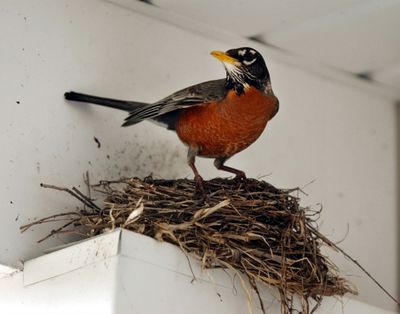If you build it, they will come
A few tips can help your feathered friends feel right at home

You’re not the only one who has noticed, day by day, that the sunlight is lasting longer. It’s the very thing that drives the birds, and with every added solar-powered minute, their little procreating hearts are pounding: “Time to build a nest. Time to build a nest.”
Domesticity rules as winter thaws to spring, and nest-building is the full-throttle pursuit, whether in the woods or your backyard.
The birthing room might be tucked inside a birdhouse dangling near your porch or in a mud-daubed nest harbored in the boughs of a gnarly old oak.
(Keep in mind, most songbirds turn their beaks at four walls and a roof over their heads, inclined only to sink their feathered bottoms into the classic open-cup nest – a mind-blowing architecture of grasses, sticks and whatever recycled bits strike the featherer’s fancy.)
Beautiful thing is, you can leap into the aviary adventure by playing along with any one or all of the tidbits we’ve gathered from some of our very best birding friends: Laura Erickson, author of “The Bird Watching Answer Book” (Storey Publishing, $14.95) and science editor at the Cornell Lab of Ornithology in upstate New York; and birdscaper Tim Joyce, manager of a Wild Birds Unlimited store and walking-talking encyclopedia when the subject is anything ornithological.
Jumpstart the nesting: Leave out short lengths of twine, or cotton batting, tucked in a clean suet cage or wedged right into tree bark. Lengths longer than 4 inches could tangle up a bird, so make that the maximum.
Forget the rainbow: Folks used to think it was smart to leave white or red bits of yarn, so you could spot the nests as trees leaf out. Unfortunately, that makes it easier for predators to pick out the wee broods too.
Beige (and assorted khaki hues) is beautiful in the bird department. Except for tree swallows who insist on it, white is not a bird-friendly color. (Swallows line their nests in white feathers, so if you know of a friendly chicken farm, have at it. You’ll make your tree swallows swoon.)
Ditch the perch: Seriously, break off that no-good dowel. No songbird will be dawdling on the front porch, and it’s an open invitation for house sparrows to barge in and take over the digs – dumping the eggs if they have to.
Never mind cute: When it comes to birdhouses, birds will take au naturel any day. If there’s paint or wood preservative on a house, be sure it’s marked “safe for indoor use” or “safe for playgrounds.” Otherwise the noxious fumes will do in the little birdies.
You’re likelier to find bird-friendly housing, to buy or build, if you do a computer search for “nesting box” instead of “birdhouse,” a term that’s likely to have a too-high cuteness factor.
If I had a hammer: Inclined to build your own birdhouse? Work with plans from folks who know birds. Two great sites: Cornell Lab of Ornithology’s nestwatch.org and the North American Bluebird Society (nabluebirdsociety.org).
And a simply marvelous wisdom-packed manual: Carrol Henderson’s “Woodworking for Wildlife: Homes for Birds and Animals” (Minnesota Department of Natural Resources, $19.95).
Beware the hole: If you put out wren or chickadee houses, don’t make the hole bigger than 1-1/8 inches, or house sparrows will move right in. Bluebird box holes shouldn’t exceed 1-9/16 inches, or starlings will barge in.
Metal hole protectors will keep pests from pecking or gnawing a bigger hole; they’re available at Wild Birds Unlimited stores (wbu.com).
Interiors matter: If the wood inside the birdhouse box is too smooth, baby birds can’t get the traction to climb out the hole when it’s time for starter flights. Rough-cut plywood is great, or score the inside; maybe tack up sandpaper, or small strips of wood as a birdie ladder.
Down with dryer lint: Do not use dryer lint if you’ve used dryer sheets or any detergent – and then only if your clothes are 100 percent natural fibers. When that lint gets wet, it crumbles. And built into a nest, that’s a recipe for disaster.
Furry caveat: If you use anti-flea treatment on your dog or cat, that flea repellant is harmful to baby birds. If you don’t, then brush away and leave the fur out in clumps, in a clean suet cage or wedged into tree bark.
Be a good egg: Mama birds need extra calcium in spring to make for extra-hardy shells. Recent studies show that in some areas acid rain has leeched the calcium out of soil, so do this: Crush shells from hard-cooked eggs and leave them out for birds to eat.
If you’ve got uncooked eggs but are willing to share those shells, bake the shells at 250 degrees for 20 minutes. Don’t microwave – they’ll shatter.
Will cook for birdsong: Want to make your birthing birdies happy? Whip up a batch of “peanut butter pudding” from the Audubon Society of Omaha: Find the recipe at audubon-omaha.org/bbbox/ bluefood.htm.
Compass confusion: You might bump into some study telling you birds are happiest when their birdhouse hole is on the north side. But you’re just as likely to bump into another one swearing they want the hole facing southward. Or east. Or west.
Never mind them all. Your birds will let you know if they approve of your positioning. And it’s a good thing if your house has a little sway, dangling on a cord; that keeps outlaws from breaking in on the baby brood.
Delight a chickadee: Pack a birdhouse with cedar shavings (untreated, please) and the nest-building chickadees will have at it, burrowing out a cavity to lay their eggs. Self-sufficient little souls, they like to think they’ve done the work without any help.
Only use wood shavings that are labeled as safe for pets, or shaved from wood that you know is untreated.